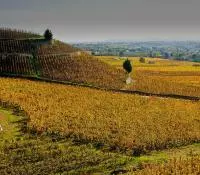Territory and terroir
Tales of the riverbank
Forming a corridor between the Mediterranean and Northern Europe, the Rhône Valley extends over six French departments : Ardèche, Drôme, Gard, Loire, Rhône and Vaucluse. The region draws its strength from this rich and powerful river, which shapes its landscape and moulds its character.
The wines grown between Vienne and Avignon, bordered by the Massif Central, the Alps and the Mediterranean Sea, draw their strength from the sun and caressing wind, and from the determination of the region’s many wine-growers to produce quality wines while respecting the environment. These wines, crafted and inspired by a wide range of grape varieties and terroirs, give pleasure to wine-lovers in all parts of the world.

Soils of the Rhône Valley
Granite, sand, clay... the soils of the Rhone Valley are as rich as they are diversified. Each soil gives the wines different properties and qualities. Learn to differentiate them and become an expert.
In the northern, a particular geology
In the northern part of the appellation, abrupt slopes with steep gradients that extend to milder slopes where terraced plots permit optimal use of the surface area. Vegetation is primarily composed of sessile oak or white oak and deciduous trees. Main soil types in the northern rhône are clay, rocky and granite soils.
In the southern, a fragrant vegetation
In the southern part of the appellation, Vineyards coexist here with fragrant vegetation. The mediterranean environment is marked by “garrigue” or scrubland, lavender fields, truffle oak, olive groves, white and green oak and pine. Vast, flat plains are home to vines and market gardens and are protected from strong Mistral winds by hedge rows of cypress and poplars. Main soil types in the southern rhône are clay, rocky, limestone and sandy soils.
Soils of the Valley
The rich soils of the Rhône Valley gives special characteristics to wines.
In the Rhône Valley, we have 5 types of soils:
- Clay soil: there are giving deeply coloured, heady, fine, aromatic and tannic wines.
- Stony soils: there are giving powerful, heady, structured wines that can age.
- Limestone soils: there are giving light, aromatic wines, supple, round, fat, floral, fruity.
- Granitic soils: there are giving structured wines with intense colour, finesse, balanced acidity.
- Sandy soils: there are giving light wines, subtle freshness and fine, elegant, light tannins.


